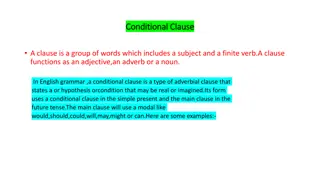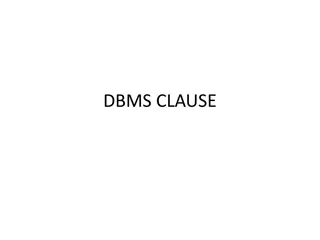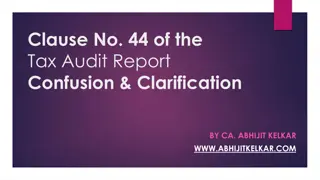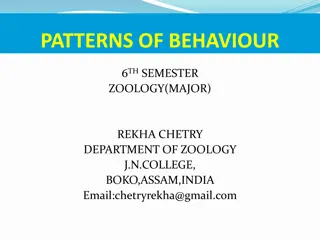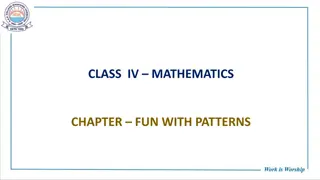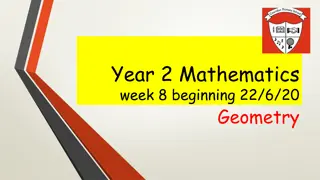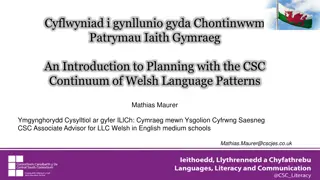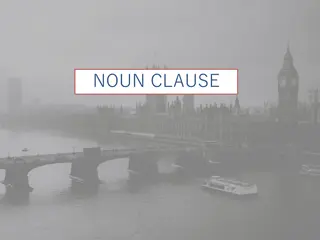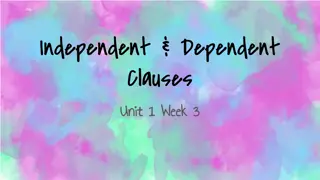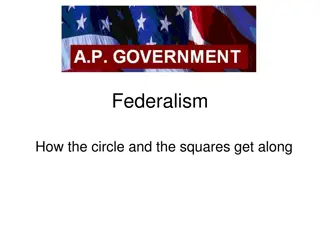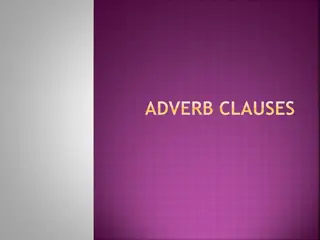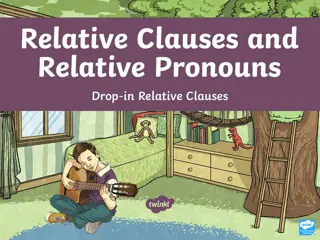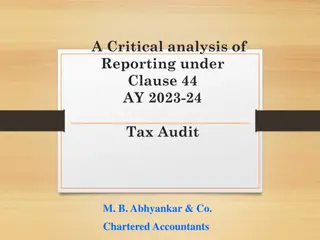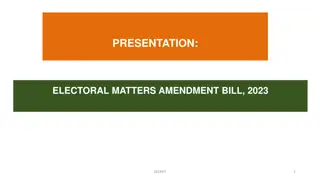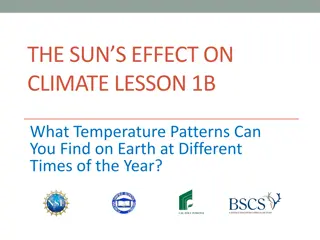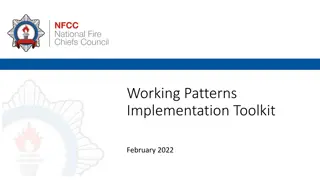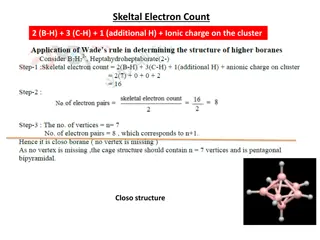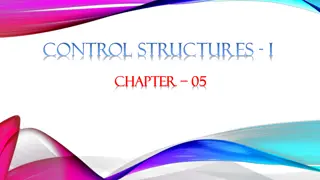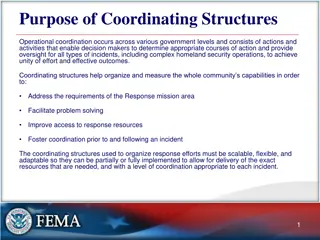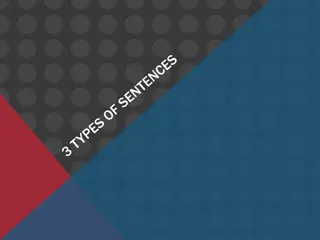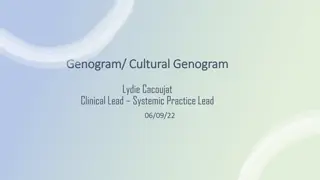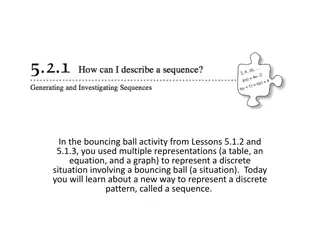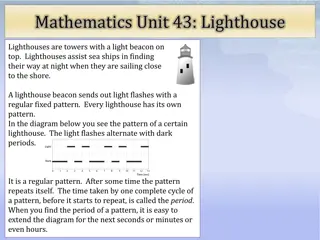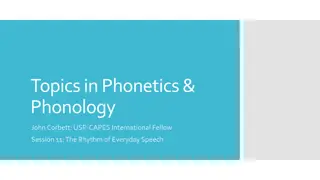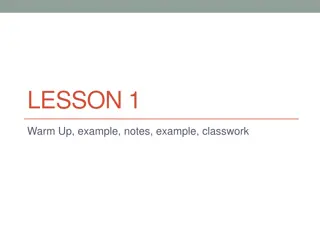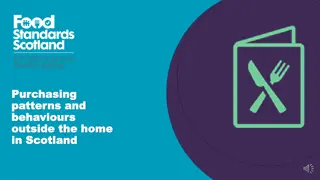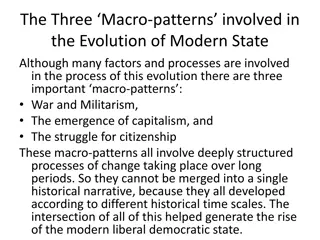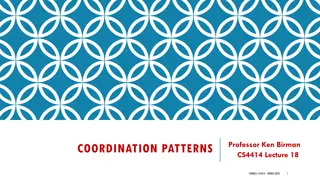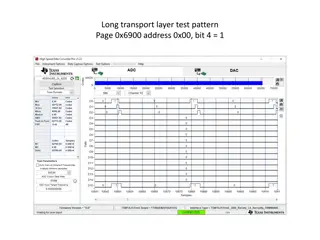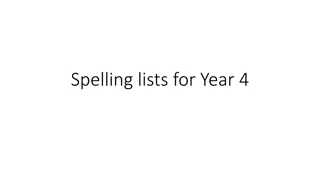Understanding Basic Clause Patterns and Structures
Explore the core concepts of clause patterns, structures, and functions, including independent and dependent clauses, sentence types, compound sentences, and conjunction usage. Learn about the components of a clause, how to identify independent clauses, and how they can be linked to form compound sentences. Discover different ways to introduce independent clauses, coordinating conjunctions, and conjuncts in sentence structure.
Download Presentation

Please find below an Image/Link to download the presentation.
The content on the website is provided AS IS for your information and personal use only. It may not be sold, licensed, or shared on other websites without obtaining consent from the author. Download presentation by click this link. If you encounter any issues during the download, it is possible that the publisher has removed the file from their server.
E N D
Presentation Transcript
Basic Clause Patterns, Structures and Fuctions
Core of the presentation 1. Independent and dependent clauses 1a Finite, Non-finite and verbless clauses 1b Clauses classified by their semantic function 2. Clauses classified by clause elements (the basic clause patterns structures) 2a variations on clause patterns 3 Sentence (simple, compound, complex and compound-complex sentences) 3a Major types of independent clauses (simple sentences)
What is a clause? The whole sentence A part of a sentence Subject and Verb Other sentence elements: Object, complement or adverbial Clause independent or dependent
Independent clause (Main clause) Complete in itself Does not depend on another clause The main idea of a sentence Independent clause simple sentence Subject and Predicate
Can be linked to another independent or dependent clause Compound sentences Coordinating conjunctions: And, or, but, yet, for, nor, so
An example of a compound sentence Jack did not mean to do it, but he did it anyway What clauses and conjunctions does the sentence consist of? Two independent clauses (Jack did not mean to do it/he did it anyway) One coordinating conjunction (but)
An independent clause can be introduced by: The subject (Marianne studied hard for the test) Coordinating conjunction (But the teacher gave her a difficult task) Conjunctive adverb (conjunct) (She did not study. Therefore, she failed)
Conjuncts (linking adverbials or conjunctive adverbs) Connectors of structure Mobile, often separated from the rest of the clause Examples: above all, consequently, firstly, further, in conclusion, nevertheless, therefore, finally, moreover, on the contrary, incidentally, namely, to conclude, to sum up Try to translate them into Slovak
Translation of particular conjuncts above all (predov etk m), consequently (n sledne, preto, v d sledku), firstly (za prv ), further (okrem toho), in conclusion (na z ver), nevertheless (av ak, napriek tomu), therefore (preto, z toho d vodu, a tak), finally (nakoniec), moreover ( alej, navy e), on the contrary (naopak), incidentally (n hodou, mimochodom), namely (menovite, toti , a to), to conclude, to sum up
Dependent clause (subordinate clause) The subordinate idea of the sentence Subordinated to another clause Dependent on another clause for meaning and context Cannot stand on its own Necessarily related to an independent clause Subject and Predicate (but related to the independent clause main clause)
Dependent clauses Connected to independent clause (s) By means of subordination Subordinating conjunctions or subordinators
Subordinators Simple (after, although, as, because, since, where, whoever, etc.) Complex most of them ending in as or that (as far as, as soon as, inasmuch as, as long as, considering that, supposing that, except that, so that, as if, as though, even if, even though, in case...) Correlative (as...so, although...yet, even if...yet, while...yet, if...then, once...then)
Translation of subordinates as far as (pokia , o sa t ka, pokia ide o), as soon as (hne ako, len o), inasmuch as (vzh adom k tomu, pokia ), as long as (pokia ), considering that (s oh adom na to), supposing that (za predpokladu, dajme tomu), except that (okrem toho, e), so that (a tak), as if (akoby), as though (akoby), even if (aj ke ), even though (napriek tomu), in case (v pr pade)...
Example of subordinate clause She was late for the meeting because her car would not start Her car would not start dependent clause Because conjunction Depedent on the rest of the sentence for meaning Subordinate clauses should not be evaluated outside of the sentence
A dependent clause may be introduced by: Subordinating conjunction (after, while, because, if, although, as, since...) Wh-word (who, which, where, when, whose, how...) That A non-finite verb (-ing, -ed, to-inf) By inversion (Had I been there...)
Classification of Clauses 1. In terms of clause elements (7 basic clause patterns types, SV, SVO...) 2. In terms of verb phrase structure (finite, non-finite, verbless) 3. In terms of clause function (nominal (ved . v. podmetov ), relative (vz a n ), adverbial (pr slovkov v.) clauses)
1. Classification of Clauses In terms of clause elements Subject and a Verb Phrase Subject invisible in imperatives and some dependent clauses Other major clause elements depending on the potential of the individual verb (adverbials can be freely added to all patterns) Verbs (transitive, intransitive, copular) Intransitive verbs (combine only with a subject)
7 basic types (clause patterns, structures) SV SVA SVC SVO SVOO SVOC SVOA
1. S + V SV Subject-verb phrase S+V The boy cried. Intransitive verb
2. S + V + A Subject, verb phrase, obligatory adverbial Henry is in Paris. Adverbial less mobile in this case, cannot be left out
3. S + V + C Subject, verb phrase, subject complement Ellen is a teacher/pretty. Subject and copular verb
Two patterns The characterising pattern (What is/was X like? How did X change/has changed?) She remained scared Tom became a scientist The identifying pattern Which one is/was X? The use of copular be Mr Miller is the president of the society.
4. S + V + 0 Subject, verb phrase, direct object Subject, monotransitive verb, a direct object She wrote a letter.
5. S + V + O + O Subject, verb phrase, indirect object, direct object We gave him a nice present. ditransitive verb
6. S + V + O + C Subject, verb phrase, direct object, complement They found it difficult. Complex transitive verb
7. S + V + O + A Subject, verb phrase, direct object, obligatory adverbial I took the book from the shelf. Adverbial location Adverbial cannot be moved in this case
The same verb may enter into different patterns: SV: I was singing. SVO: I was singing an English song. SVOC: She has made me fool. SVO: She made coffee.
Variations on clause patterns Inversion of the subject and the verb phrase (Had I been there, I would not have said a word) Fronting of objects or other elements (Her character I do not like) The passive (The window was broken) Existential there (There is a stranger standing in front of the house)
Extraposition anticipatory (introductory) it (It was obvious that she took it) Clefting clause can be divided into two parts, each with its own verb (It was his dog that ate the sandwich) Ellipsis omission of elements which are recoverable from the context (She thanked him but (she) did not hear any response)
Postponement of objects (Mr Hunter has repeatedly made clear his strong opposition to changing the rules) All variations reordering the information Communicative dynamism achieved Grammar of English allows us to do that!
Examples for Inversion "I am hungry", said Bill. - Subject-verb inversion Has Sam read the paper? - Yes no question formed using inversion (S-O inversion) At no time will Jessica say that. - Subject- auxiliary inversion with a fronted negative expression. Had I been there, I would have told them. (Inversion in conditional sentences)
Other cases for inversion So tired (Such tiredness) did we feel that we fell asleep. (so, such) Never has Jim tried that. (negative inversion)
Inversion with: hardly / scarcely / barely ... when no sooner ... than
Meaning: sotva Hardly had I arrived home when my phone rang. Scarcely had she finished reading when she fell asleep. Barely had they won the match when the coach had a heart attack. No sooner had the company launched its new product than it went bankrupt.
Clauses classified by verb structure Finite clause (verb phrase tense and modality) Finite verb (tense, person, number) reads, spoke, has gone... I do not like people who talk too much Non-finite clause (dependent cl.) does not express tense, person or number ing, ed, infitive clauses
Examples for non-finite clauses - ing clause: Coming in for landing, the place was contacted by the tower. - ed clause: Broken in many pieces, the antic vase was lying on the floor. Infinitive clauses: He did not want to go there (to infinitive), Rather than go there by car, I d prefer to take the train (bare infinitive)
Verbless clause No verb element Often also no subject Possible to recover the missing form of the verb be and subject from the context Though eighty this year, my grandpa is very active.
Clauses classified by semantic function Nominal clauses may function as subject, object, comeplement, adjective, prepositional complement... I did not ask her what she had done with the money. (Od) Relative (adjective clauses) His uncle, who is already 62, likes to play golf. Adverbial clauses (providing infos about what is going on) Susan won t join us because she is too busy with HW.


